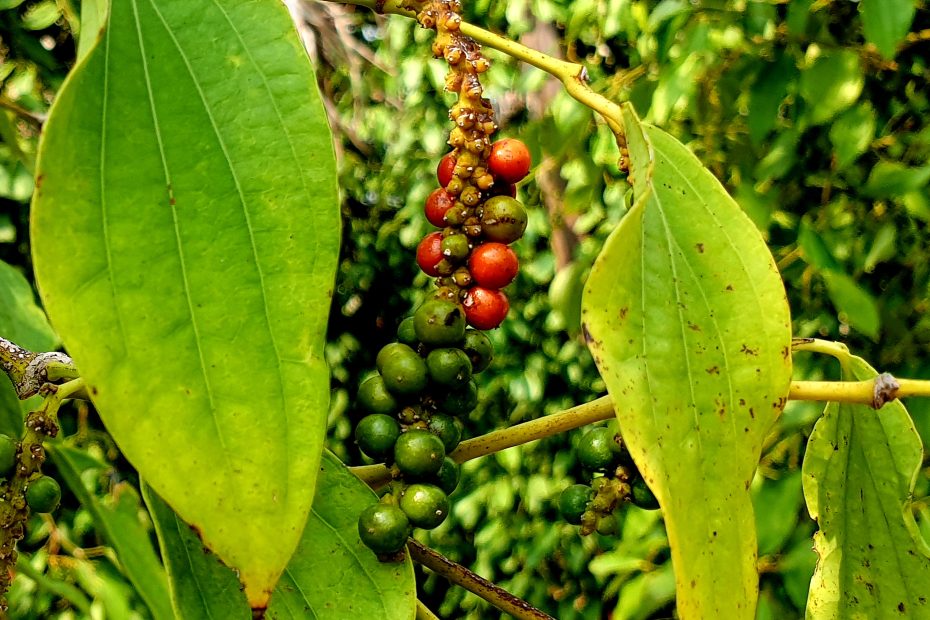In the heart of Cambodia lies a treasure that has captured the attention of culinary enthusiasts and chefs around the world — Kampot pepper. Far beyond being just a spice, Kampot pepper holds a mystique and allure that is deeply rooted in its origins, cultivation methods, and unparalleled flavor profile. In this article, we delve into what makes Kampot pepper truly special and why it has earned a place of distinction in the global gastronomic landscape.
What is special about Kampot pepper?
A Terroir Like No Other
The secret to Kampot pepper’s extraordinary flavor lies in its terroir — the unique combination of soil, climate, and geography that shapes its growth. Nestled between the lush mountains and the coast of southern Cambodia, the Kampot region is blessed with mineral-rich, reddish-brown soil, and a tropical climate. This distinctive environment infuses the pepper plants with a complexity of flavors, including hints of eucalyptus, mint, and citrus. It’s a terroir that cannot be replicated elsewhere, giving Kampot pepper its singular character.
Varieties that Dance on the Palate
Kampot pepper comes in several varieties, each with its own distinct flavor profile. Black pepper, known for its robust spiciness and earthy undertones, is the most well-known. White pepper, harvested from the same berries but processed differently, exhibits a milder and more delicate flavor. Red pepper, left to ripen on the vine, boasts a sweeter taste with a hint of fruitiness. Green pepper, picked before full maturity, offers a fresh and lively taste. The versatility of these varieties allows chefs and home cooks alike to experiment with a range of tastes in their culinary creations.
Cultivation and Craftsmanship
The cultivation of Kampot pepper is a labor of love. Farmers meticulously tend to their pepper vines, nurturing them throughout the seasons. Hand-picking ensures that only the ripest berries are harvested, preserving the pepper’s exceptional quality. The berries are then sun-dried and sorted by hand to guarantee uniformity and purity. This craftsmanship is a testament to the dedication of the local farmers who uphold the legacy of their forebears.
A Flavor Journey
What sets Kampot Pepper apart is its ability to take diners on a journey of flavors. When used in cooking, its layers of complexity unfold, revealing the essence of the region in each bite. Its spiciness is not overpowering; instead, it’s a warm and lingering heat that dances on the palate. The citrusy and herbal notes add dimension to dishes, elevating even the simplest of recipes to culinary artistry.
You may check: Kampot Pepper Crab: A Culinary Journey to Remember
Preserving Tradition and Sustainability
Kampot pepper is more than a spice; it represents a way of life and a connection to history. Its cultivation methods have been passed down through generations, fostering a sense of tradition and community among local farmers. Additionally, the sustainable farming practices used in Kampot pepper production contribute to the preservation of the environment and the empowerment of local communities.
How Many Types of Kampot Pepper?
- Black Pepper: This is the most common and well-known variety of Kampot pepper. Black pepper is made from fully matured green berries that are harvested and sun-dried until they turn black. It has robust spiciness and earthy notes, with a warm and lingering heat. The black variety is often used in a wide range of dishes for its versatile flavor.
- White Pepper: White pepper is derived from the same berries as black pepper but is processed differently. The ripe berries are soaked in water to remove the outer skin, revealing the pale inner core. This inner core is then dried to create white pepper. White Kampot pepper has a milder and less pungent taste compared to black pepper, with subtle floral and citrusy undertones.
- Red Pepper: Red pepper is harvested from fully matured berries that are left on the vine longer than those used for black pepper. The berries turn a deep red color as they ripen. Red Kampot pepper is slightly sweeter than black pepper, with fruity and berry-like flavors. It has moderate spiciness and a distinct aroma, making it a unique choice for culinary experimentation.
- Green Pepper: Green pepper is harvested before the berries reach full maturity. It is often used fresh or pickled. Green Kampot pepper has a vibrant, zesty flavor with a mild spiciness. Its taste is characterized by its freshness and slightly tangy notes, making it a popular choice for salads, seafood, and other dishes where a bright, peppery kick is desired.
These four varieties of Kampot pepper offer a diverse range of flavors and aromas, allowing chefs and home cooks to experiment and enhance their dishes with the unique characteristics of each type. The cultivation and processing methods for these varieties contribute to the complexity and depth of flavors that set Kampot pepper apart.
You may check: Best Cambodian Ingredients In Khmer Cuisine
How Hot Is Kampot Pepper?
Kampot pepper is known for its complex flavor profile rather than extreme spiciness. It typically offers a moderate level of heat that is well-balanced with other flavor notes. The heat of Kampot pepper can vary depending on the variety and the individual pepper, but it generally falls within a range that is enjoyable and versatile for culinary use.
Here’s a rough comparison of the heat levels of Kampot pepper to other commonly known chili peppers, based on the Scoville Heat Scale (SHU):
- Kampot Black Pepper: The black variety of Kampot pepper has a moderate level of heat. It is much milder than chili peppers like jalapeños, typically ranging from around 1,000 to 2,000 SHU. This level of heat adds a pleasant warmth to dishes without overwhelming the palate.
- Kampot Red Pepper: Red Kampot pepper, being fully ripened, is slightly milder in heat compared to the black variety. It usually falls within a similar range of around 1,000 to 2,000 SHU. The red pepper offers a sweeter and fruitier flavor with a touch of spiciness.
- Kampot Green Pepper: Green Kampot pepper is generally the mildest of the varieties. Its heat level is often comparable to or slightly below that of black and red Kampot pepper. The emphasis with green pepper is on its fresh, zesty taste rather than intense spiciness.
It’s important to note that heat perception can vary from person to person, and factors such as personal tolerance to heat and the amount of pepper used in a dish can influence how spicy it tastes. Kampot pepper’s appeal lies in its ability to provide a well-rounded spiciness that enhances the overall flavor of a dish without overpowering it.
What Does Kampot Pepper Taste Like?
Kampot pepper is celebrated for its complex and multifaceted flavor profile, which distinguishes it from other pepper varieties. The taste of Kampot pepper is a harmonious blend of various flavor elements, making it a unique and sought-after spice. Here’s a breakdown of what Kampot pepper tastes like:
- Robust Spiciness: Kampot pepper carries a moderate level of spiciness that is pleasant and well-balanced. It provides a warm and gentle heat that doesn’t overwhelm the palate, making it suitable for a wide range of dishes.
- Earthy and Woody Notes: There is an earthy undertone to Kampot pepper that gives it a sense of depth and richness. This quality comes from the region’s mineral-rich soil, which imparts a subtle woodiness to the flavor.
- Citrusy Zing: One of the standout characteristics of Kampot pepper is its citrusy zing. Many tasters describe hints of lemon, lime, or even a touch of grapefruit. This bright and refreshing note adds a unique dimension to the pepper’s taste.
- Herbal Aroma: Kampot pepper often carries a delicate herbal aroma, with traces of eucalyptus, mint, and thyme. This herbal quality contributes to the pepper’s overall complexity.
- Floral Undertones: Some varieties of Kampot pepper, especially the white variety, exhibit subtle floral undertones. This can add a nuanced layer of fragrance to dishes.
- Balanced Bitterness: While black pepper is known for its slight bitterness, Kampot pepper’s bitterness is well-balanced and not overpowering. It complements the other flavor elements without dominating.
- Savory and Umami: Kampot pepper enhances the savory and umami aspects of dishes. It can accentuate the natural flavors of ingredients and contribute to a well-rounded taste profile.
- Clean Finish: The flavor of Kampot pepper is often described as clean and crisp, with a lingering aftertaste that is both satisfying and nuanced.
Incorporating Kampot pepper into dishes adds depth, complexity, and a touch of Cambodian terroir. Its ability to seamlessly blend spiciness with citrusy, earthy, and herbal notes sets it apart as a versatile and highly prized spice in both traditional and modern culinary application
Is Kampot Pepper Expensive?
Geographical Indication
Kampot pepper has been granted Geographical Indication (GI) status, which means that it must be produced in the Kampot region of Cambodia to be labeled as such. This designation ensures that the pepper’s origin and quality are maintained, but it also restricts its production to a specific area, limiting the supply.
Labor-Intensive Cultivation
Kampot pepper is cultivated using traditional methods that require significant manual labor, from planting and tending to the pepper vines to harvesting and processing. These labor-intensive practices contribute to the higher production costs.
Limited Production
The Kampot region has a relatively small pepper-producing area compared to other pepper-growing regions. This limited acreage results in a lower overall yield, making Kampot pepper less abundant and more exclusive.
Unique Flavor Profile
Kampot pepper’s distinct flavor profile, characterized by its complex taste and aroma, contributes to its premium status. The unique combination of flavors, including citrusy notes, herbal undertones, and a balanced spiciness, sets it apart from other pepper varieties.
Sustainable and Traditional Practices
The sustainable and environmentally conscious farming practices employed in Kampot pepper cultivation, while beneficial in many ways, can also add to the cost of production.
Hand-Processing
Kampot pepper is often hand-picked, sun-dried, and sorted, which requires meticulous attention to detail and careful handling. This hand-processing contributes to the labor and time invested in producing high-quality pepper.
While the cost of Kampot pepper might be higher compared to other pepper varieties, many people consider it a worthwhile investment due to its exceptional quality, unique flavor, and the support it provides to local Cambodian farmers. It’s important to remember that the price reflects not only the spice itself but also the craftsmanship, cultural heritage, and sustainable practices behind its production.
Conclusion
Kampot pepper isn’t just a condiment; it’s an embodiment of a region’s soul. Its uniqueness is a product of nature’s benevolence and human dedication. When you savor the distinct flavors of Kampot pepper, you’re not just experiencing a taste — you’re partaking in a journey that spans generations and landscapes. The allure of Kampot pepper lies in its ability to transcend the culinary realm, immersing us in the story of a land and its people, one peppery bite at a time.



